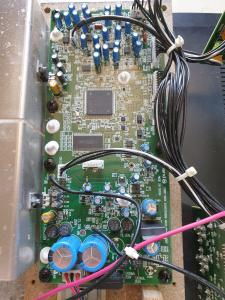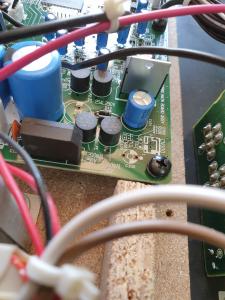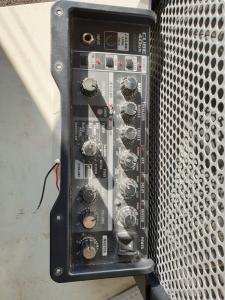I even threw out the digital amp that I built for the exam which had active bass/treble controls built into a feedback loop.
Does that mean you're a bit handy with a digital amp's pcb, a schematic, and a non-functioning amp @rocknroller912 ?
Online guitar making courses – guitarmaking.co.uk
Looks like you are the forum valve expert so far
Some people call me a tool, others are less complimentary. Tools being useful things.
@tv1010101
Possibly although I haven't looked at electronics for several years but I do have two clever friends who are amenable to questions. What problem do you have.
Some people call me a tool, others are less complimentary. Tools being useful things.
I have a Roland Cube 60 (cost me peanuts), which I was intending to cannibalise just for the cab & speaker.
However - if it worked - it seems like it'd be quite a versatile thing, and me cannibalising it might be a waste.
But - *if* it worked! The problem is that (I'm guessing) the power amp circuit is blown. Output from the amp is *Very* low (1w maybe - certainly not 60w). I took it apart this afternoon, thinking that if there was something obviously "blown" then perhaps I could source a spare component or 2 and replace the blown bits. But everything looks OK, so I wouldn't know where to start.
Or I could just revert to planA and bin the electronics and just use the cab & speaker.
Online guitar making courses – guitarmaking.co.uk
@tv1010101
Amps usually pass a signal through different stages to get up to full power, first a pre amp then the main power part, which I'm sure you already know. It sounds like you are getting only the pre amp signal, but if the power part is blown then nothing would pass through.
Basic fault finding is to start from the obvious or big things and work down to the small, so look at any internal fuses or transformers going from the mains input to see if they have scorch marks or signs of burning. Manufacturers often use cheap transformers that burn out and there could be step down voltages to power different parts which are not fully working giving reduced output. Some components work between a voltage range so they can work at the lower end but not very well.
It could be a faulty connection to the speaker. If it has an auxiliary output jack try taking a lead out to another amp and see what power you get.
Modern pcbs have printed boards rather than soldered components so if you traced the fault to somewhere in there it would be replacing the board which is the standard these days. Good luck keep posting if you get anywhere.
Some people call me a tool, others are less complimentary. Tools being useful things.
Cheers @rocknroller912. I'll look at it more closely when I get some time over the next couple of days and try to spot anything obvious.
If nothing obvious then I'll probably just revert to planA and dump the electronics and just use the amp/cab to house another mini-amp-build.
🙂
Online guitar making courses – guitarmaking.co.uk
It could be something simple like a fuse - it could be a failed soldered joint on the PCB - bad component....
I have a Cube 60 schematic (circuit diagram) in front of me - there is a preamp out and main in (we would probably call it an effects loop now) can you connect a signal into the main in - do you get a reasonable sound then?
Some troubleshooting can be done with the amp in bits but beware there will probably be unprotected mains terminals in there - you could damage yourself....
Measure once........
Measure again.........
Sod it - make tea!
Hmmmmm.
PlanA is looking good @frocesterbill !!
Apparently (ie according to the previous owner) the amp had started hissing/buzzing when switched on, but then it'd settle down and work OK, for a while before it came my way.
Which sounds more like a component gradually deteriorating/failing rather than a sudden BANG event like a fuse blowing?
But I'm really clueless re electronics ...
Online guitar making courses – guitarmaking.co.uk
How old is the amp?
Electrolytic capacitors age and fail - they are the largish tubular things - the tops bulge at first and then may burst open.
Bad soldered joints can cause problems - if the amp has been dropped then they can crack/brake - sometimes if the joint wasn’t properly flowed it can work for a while - it is worth getting a good light and having a good look for any that don’t look right, if you find one just remelt the solder and let it cool - you can use a multimeter in continuity mode as demoed by Mark to check that there is a good joint between lead and board.
Measure once........
Measure again.........
Sod it - make tea!
@tv1010101
I would agree with the other comment, hissing sounds like a capacitor failure. Large value capacitors have an electrolyte which could be overheating and boiling. If it's a coupling capacitor between two stages it might explain the power loss.
Capacitors used for tone controls have a ceramic disc which is different.
Some people call me a tool, others are less complimentary. Tools being useful things.
Thanks @frocesterbill @rocknroller912
I've no idea how old the amp is, but I'd say "a fair few years". However, it's in good condition, so it's not had a hard life. There's no signs of external damage, not even scratches, on the cabinet, so I think damage caused by it being dropped are unlikely.
I'll check over the electrolytic capacitors and see if I can spot any dodgy looking ones.
PlanA is still favourite (the cab & speaker were the only reason that I grabbed it when offered to me), but I just don't like binning stuff when it might be a simple fix! Though, if I fix this, then I'd have to make another cab for a different speaker ...
Online guitar making courses – guitarmaking.co.uk
@frocesterbill @rocknroller912
Couple of pics of the innards ...
I think this is the main amp board (the other board hosts the various inputs & controls from the front panel of the amp. Nothing obvious blown or burnt. I checked the fuse, which was good too.
However...
See the two large caps, bottom of the board, next to each other? Nothing visibly wrong with them, but to the right of them, there's another smaller one (under the red (speaker) wire. Immediately above that smaller cap, is a small black component that's got a metal side to it.
Closer-up pic;
I'm guessing that component ("IC27") is doing some fairly critical function. It was bent backwards, and the metal edge was touching the side of the blue cap (C181). Might that have caused the problem?
I'm also guessing that perhaps the speaker cable was pushing on it slightly, causing it to bend. Maybe that pressure was enough to cause the original hissing/buzzing sound, and - when it finally bent too far - then caused the major drop in output power?
To finish-up with my guessing, should I (a) take the circuit board off the backing board and check the solder joints (in case, having been bent, that component is not properly soldered onto the board), or (b) just plug the amp in and (carefully) see what happens?
Online guitar making courses – guitarmaking.co.uk
That component (IC27) looks like it might be a voltage regulator - that is a more recent amp than the one I found a schematic for - looks like it has DSPs for effects an poss amp models - bung a picture of the front panel up if you get a chance...
Measure once........
Measure again.........
Sod it - make tea!
D'oh! It's going to help if I manage to get the amp model correct. Sorry @frocesterbill.
🙁
Cube 40 gx.
Online guitar making courses – guitarmaking.co.uk
Valve amps are quite simple circuits, far fewer components than a solid state amp.
Some have point to point wiring - the main components (valves, transformers, controls) are bolted into the chassis and the rest of the components are arranged to connect the fixed bits together.
Some have the main components bolted as in point to point and the rest of the components on tag or turret boards - the board is an insulating material with carefully arranged tags or turrets as nodes to solder components to with wires run from tags to the fixed components.
The final variant has printed circuit boards with some or all of the components mounted on them.
It is worth tracking down Uncle Doug on You Tube - he repairs and restores amps - you won’t find Uncle Doug working with amps with PCBs but the other two variants feature - he is worth a watch.
Measure once........
Measure again.........
Sod it - make tea!
Quick update @frocesterbill @rocknroller912 -
After a bit of fiddling with the innards of the amp, I thought I'd give it a go (what's the worst that can happen) ...
Now that UK Power Networks have been out and fixed everything and got power restored to the rest of Norfolk I can report that ..
THE AMP LIVES.
(the bit about UK Power Networks was a joke).
All I did was take it apart, straightened that component that looked like it had been bent backwards and was making contact with the Capacitor next to it, so that it was no longer bent backwards ... then I connected the guitar & power, switched on and ...
It just worked!
Everything seems to be functioning normally. Plenty of power/output. I'm now an amp-fixer.
Online guitar making courses – guitarmaking.co.uk
All I did was take it apart, straightened that component that looked like it had been bent backwards and was making contact with the Capacitor next to it, so that it was no longer bent backwards ... then I connected the guitar & power, switched on and ...
It just worked!
Was that good luck or good management...either way it’s a lot further than I would have managed to do..
I have too many guitars...said no one in the world..ever!
@tv1010101
Great news you have struck another blow against the throw away culture. I hope it's given you the confidence to analyse problems.
Bonus points for the forum as well.
Some people call me a tool, others are less complimentary. Tools being useful things.
Cheers guys!
I just looked at it really. There were no obviously blown Capacitors. No obviously dodgy solder joints. Nothing obviously missing or disconnected.
The only thing that looked "wrong" was that one component which looked bent out of shape and appeared to be touching one of the Capacitors (though not sure why that would have mattered).
Bent it back, and all is - magically - good again.
It's a nice enough little amp - built in FX and amp emulators.
The only problems are;
- I really don't need another amp (particularly if I'm going to build another amp that I don't need, albeit a tasty valve-y one!)
- I now need to build another cab to house another speaker that I was going to cannibalise this one for!
😀
Online guitar making courses – guitarmaking.co.uk





